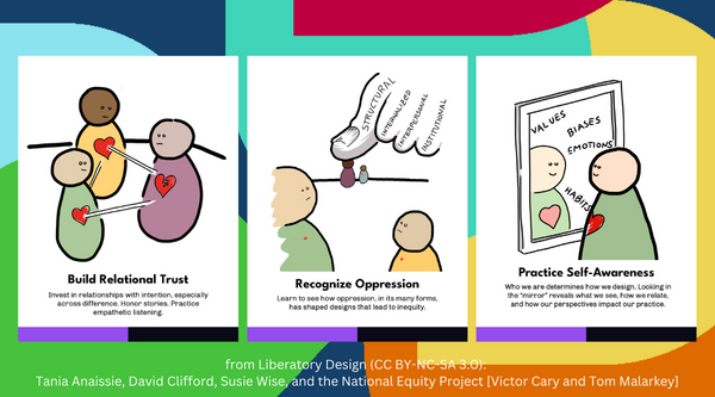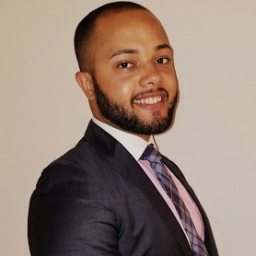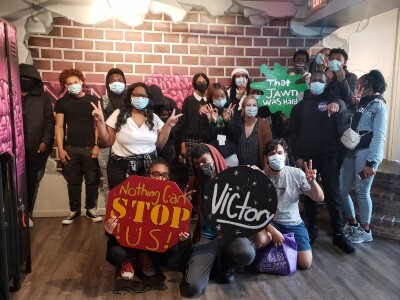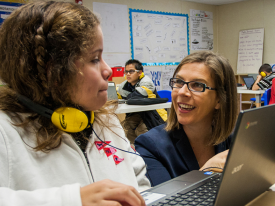Self-Actualization and Organizational Development
Topics

Together, educators are doing the reimagining and reinvention work necessary to make true educational equity possible. Student-centered learning advances equity when it values social and emotional growth alongside academic achievement, takes a cultural lens on strengths and competencies, and equips students with the power and skills to address injustice in their schools and communities.
NGLC's Evolving Approach to Evaluation Growth, Part 2
With these three shifts, we are navigating the challenges and the rewards that come from replacing a traditional performance evaluation system with a new one that is focused on learning and growth.
In my last piece about our growth approach at NGLC, I described the foundational work our team did to transform our systems and practices in order to focus on learning and growth instead of evaluation and performance. At its core, this effort has meant shifting from manifesting a dominant/western White culture worldview approach to an Indigenous one. Here, in part 2 of the series, I will focus your attention on the complexities of and relationship between self and community actualization, concepts from Blackfoot Nation that I introduced in the last piece.
It is no secret that we each have, in different ways, been products of and participated in organizations that have been led through the lens of a more dominant/western worldview. Undoing these beliefs as both a participant and organizer of this work, I deeply understand that this is a transition that takes time. It is also important to note that, at least in the beginning, the transition necessitates a both/and approach that allows the existing westernized view of evaluation to evolve into an Indigenous worldview of self and community actualization.
I will explore three paradigm shifts we have taken through the lens and perspective of my colleagues who have very intently and graciously joined me in this journey and who have offered their feedback so that we can enhance the process we developed into a 2.0 iteration that can be sustained over the years.
Analyzing our Growth Systems and Structures
In a “Notice & Reflect” session a colleague stated “[our growth model] makes me wonder about the system and what it needs to look like. There is an unwritten assumption that we are all high-performing driven people. How do we build a system where everyone is trusted to bring this work forward?” While in a hierarchical model leaders can get added benefits in the evaluation process from establishing strong relationships based on trust, I’d argue that trust is not essential. That’s because in a westernized worldview the relationship is defined by one person who is being evaluated and the other who is the evaluator with clear boundaries set between them.
I remember as a teacher while I was studying to become an administrator that one of the things that people kept saying to me was that it gets “lonely at the top.” And I certainly did experience that loneliness because I have worked in school systems that, for long, have been a construction of policies and procedures meant to help create order within a more complex structure. I would argue that the loneliness people experience at the top is directly connected to the way leaders establish relationships with their peers.
The reality is that organizations that seem to thrive are those that put an effort in prioritizing relationships. This is because as a society we have come to understand that the desire to feel that we are valued, seen, heard, and recognized is fundamentally human as explained in “Need-to-Belong” theory (Baumeister Social Psychology research). The more connected we feel with others, the more motivated we are as is demonstrated in “self-determination” theory. When we bring this key research to try and solve the question asked by my colleague it all goes back to relationships. In simplest terms, relationships matter.
In order to tend to the development of relationships within an organization there must be systems and structures in place to support that. The triad structure that we settled on (two co-directors with one staff member; see my last article for more) seemed to fit well for us. Andy offered feedback to the staff member that connected to ecosystem development and my own feedback to others centered around practice and the connection to the field. As a triad, we designed and came to a consensus on WIGs (wildly important goals) for each staff member that connected to NGLC’s strategic plan. We supported individual staff development through monthly triad meetings. We also held team meetings where we aligned our work as a team so that individual self-actualization, represented by growth on WIGs, would support community actualization and, ultimately, cultural perpetuity.
And then there’s this notion of being a group of high-performing individuals that my colleague brought up. What does this really mean? I’ve come to see the concept of high-performers as people who know traditional systems well and can generate a certain set of outcomes and outputs as determined by the systems they work within. (Like students who know how to work the system of school to get good grades and raise their GPA.) In this case high-performing is about the system itself and not necessarily about the individual and their personal development. How do we ensure we build a system for everyone? I believe the answer lies in creating systems that are responsive to individuals and bounded by a strong set of relationships that help individuals move forward in their work. Instead of having a set of meetings for the sake of having them, a leader needs to actually know the “content” so that they can give feedback that actually supports an individual’s growth. The Blackfoot Nation worldview reminds us that as human beings we are all coming into our professional work already self-actualized, we all have something to contribute. We need to honor those individual strengths to move our organization, and the communities we serve, forward.
Even as we establish new and creative ways to tend to people’s needs, we are still bound by policies and structures that do not necessarily align with this growth model. At NGLC, at the end of the year, we had to divert from the carefully constructed triad structure we developed in order to attach one leader as the official “evaluator” for each employee because of the policies that guide our Human Resources. It means that, in each of the instances where we submit an “evaluation,” the work and reflection we have done with each of our colleagues will externally be seen as a reflection of only one co-director.
Navigating Personal Growth with Organizational Needs
The system that we created this past year for our growth model has been far from perfect. One of the concerns that has been brought up by at least one colleague was in seeing the alignment between our growth process and the daily work: “the tensions that have surfaced are still there because they don’t capture the day to day work and we are still trying to navigate that.” By focusing so much on WIGs, we created the need for additional meetings where we could still speak to the other goals of each staff member’s responsibilities that were not deemed as “wildly important.” Looking back now, I can see the possibilities and myriad of ways that we could have done a better job. For example, at some point throughout the year, it felt like we were reflecting too much. Yes, there is such a thing and you can read more about it in this article on self-reflection. Our reflections were a mixture of exploration between the “what?” and the “why?” The linked article argues that we should focus more on the “what” because it helps us move away from the past and enables us to analyze results from an objective lens. I would push that one further and state that centering questions in “how” can be most beneficial. “How” questions focus our thinking on ways to solve challenges that may arise in more creative ways that are more action-oriented.
How might we approach our learning and growth in more integrated ways that do not require as many meetings? This is the question that we are trying to solve in the next iteration of our growth model. Some ideas that have surfaced are dedicating specific times to non-WIGs (not-so-wildly important goals) within monthly triad meetings or sending weekly updates on progress for high-priority items through a Gannt chart that lists all priorities for the year. This will obviously take more exploration and ideation from others on our team so that we can continue to experiment on the best ways to navigate the tensions between WIGs and non-WIGs. More on this iteration in my next article of this series.
Focusing on the Right Tools to Help Us Navigate the Journey
The last of the three shifts that I will discuss are the tools we used to navigate our learning process. This is best summarized by one of my colleague’s responses when she states, “I personally found the tool to be more of a barrier than a support. I spent a lot of time scrolling through to find my goals and had to look elsewhere (like Slack) to figure out what I was supposed to do in the tool, prepare for the next meeting, etc.” I found myself going through the same thought process as well in trying to navigate our new growth approach. I came to understand in one of our reflection meetings that I was mimicking some of what I experienced in my own complex journey with evaluation systems. These evaluation systems would often require reading through dozens of documents, understanding a multitude of policies aligned to those documents, and then being subjected to all of the different interpretations of what needed to be done and when based on individual understanding of these varied documents. When setting up systems for NGLC’s growth approach, I tried to emulate the types of systems I was used to being a product of. In reality I could have shaved a few steps, condensed a few documents into one with clearer directions, and I could have written instructions that wouldn’t require anyone to look through a variety of documents to figure out what needed to be done. In many ways the old adage of “less is more” seems pretty fitting here. That’s another thing we’re working to improve in our next iteration.
We did get some things right, though. We created meeting structures that were more fluid and aligned to the needs of each of our colleagues. We maintained an asset-based outlook on our approach to growth. And, most importantly, we always approached our work in a human-centered way. We also found a healthy balance between storytelling and evidence to show impact and growth. We are privileged in being a culture of work where we all take a learner-stance through these types of journeys and we are not afraid to ask questions that could have deep implications for how we ultimately do the work.
A Case for School Systems
Pre-pandemic, most schools and districts were focused on perpetuating systems that have been in existence for far too long and the human side of our education system seemed to take a back seat. It took a worldwide pandemic for schools and districts to pay more attention to our humanity and made topics like social and emotional development, restorative justice, and positive behavior intervention more prevalent topics in the daily work of schools.
If we have learned anything at NGLC from the schools and districts we researched through our Transformation Design initiative and our own organizational learning, it is that districts and work places that are most successful are ones where relationships are prioritized; where there is a learning culture that is anchored in supportive leadership; and where stakeholders work together to identify, understand, and address equity issues to create systems that are responsive to student needs. Thinking about new and creative ways to replace the evaluation systems currently in place in K-12 education is difficult because of a variety of issues. For one, in some districts, people can be placed in school buildings and principals do not have the autonomy they need to hire their own staff. In many places, evaluations are tied to how much a teacher gets paid. In other places, adults have to abide by rules and processes that do not align with the more personalized vision they have set out to accomplish for student learning in their classrooms. And the list of challenges that can get in the way goes on.
Even after a year into our new growth approach, we continue to learn, we continue to be human with each other, we continue to listen intently. That’s what it is all about. I leave you all with this thought from adrienne marie brown as NGLC enters our second year of self-actualization and organizational growth:
“intentional adaptation is the heart of emergent strategy. How we live and grow and stay purposeful in the face of constant change actually does determine both the quality of our lives, and the impact that we can have when we move into action together.
Learn More
Read Part 1 for more about NGLC's approach to individual and organizational growth that is closer to an Indigenous worldview that we all arrive to the planet as already fully self-actualized.
Image at top: Three liberatory design mindsets. Liberatory Design is the result of a collaboration between Tania Anaissie, David Clifford, Susie Wise, and the National Equity Project [Victor Cary and Tom Malarkey]. CC BY-NC-SA 3.0




